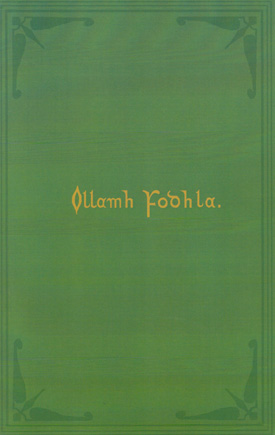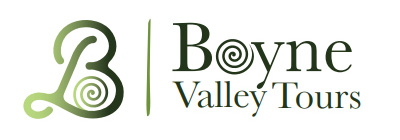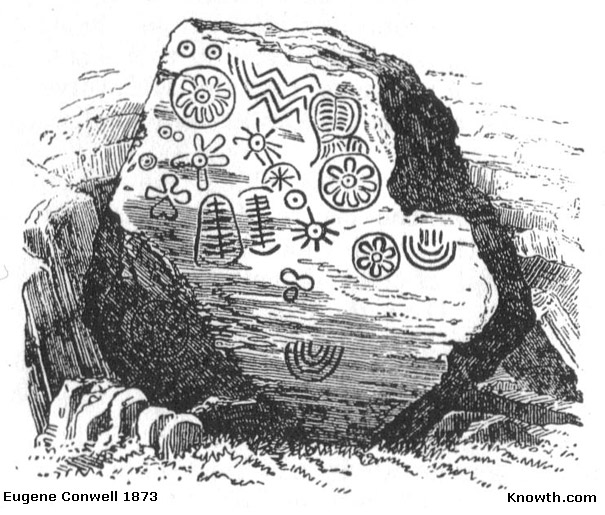Ollamh Fodhla
 Ollamh Fodhla: Discovery of the Tomb of Ollamh Fodhla, by Eugene A. Conwell. First published in 1873,
a facsimile edition was published in 2005.
Ollamh Fodhla was Ireland's Famous Monarch and Law-maker Upwards of Three Thousand Years ago.
Later research was to prove Loughcrew Cairn T to be a Neolithic (Stone Age) tomb, about two thousand older than
proposed in Eugene Conwell's book.
However this short book (69 pages) is still worth having for the drawings of the symbols on the
Cairns at Loughcrew.
Ollamh Fodhla: Discovery of the Tomb of Ollamh Fodhla, by Eugene A. Conwell. First published in 1873,
a facsimile edition was published in 2005.
Ollamh Fodhla was Ireland's Famous Monarch and Law-maker Upwards of Three Thousand Years ago.
Later research was to prove Loughcrew Cairn T to be a Neolithic (Stone Age) tomb, about two thousand older than
proposed in Eugene Conwell's book.
However this short book (69 pages) is still worth having for the drawings of the symbols on the
Cairns at Loughcrew.
Eugene Conwell, a National School Inspector was the first person to study and document the cairns at Loughcrew. While Cairn T is no longer referred to as Ollamh Fodhla's tomb, his identification system for the cairns is still used today. Clusters of Cairns are dotted around the Slieve na Caillaigh hills at Loughcrew, the main concentrations are on Carnbane East where Cairn T is the centrepiece and Carnbane West where Cairn L is located.
Purchase at Amazon.com or Amazon.co.uk
The full 1873 version can be viewed at Google Books.
Opening page of Preface:
Some portions of the following pages were originally contributed to the Proceedings of the Royal Irish Academy, in a Paper read at a meeting of that body on 12th February, 1872, "On the Identification of the Ancient Cemetery at Loughcrew, Co. Meath, and the Discovery of the Tomb of Ollamh Fodhla."Our attempt to rescue from the domain of legend and romance the memories of a locality, at one time the most famous in our island, and in so doing to revive a faded and long forgotten page in early Irish History, is here presented to our fellow countrymen, in the hope that it may be found not only not uninteresting to them, but that it may be the means of inducing others, in various localities, to turn their attention to, and to elucidate whatever remains of Ireland's Ancient Relics may be still extant in their respective vicinities.
Our very grateful thanks are pre-eminently due to the late J. L. W. Naper, Esq., D. L., who, from the time we commenced our antiquarian researches on the Loughcrew Hills, in 1863, uniformly encouraged and aided us in supplying the amount of manual labour necessary for carrying on the explorations, without which friendly encouragement and patriotic help, whilst others laughed at what appeared to them the foolish and childish occupation of a "visionary antiquary" turning over old stones, no practical result would probably ever have been arrived at. Had he lived to see it shown that the greatest, the oldest, and the most important of the Ancient Royal Pagan Cemeteries of Ireland existed on and around his own hills, we can only imagine the amount of self-satisfaction with which he would have looked back upon the part he took in contributing to restore the historic memories of the place.
Boyne Valley Private Day Tour
 Immerse yourself in the rich heritage and culture of the Boyne Valley with our full-day private tours.
Visit Newgrange World Heritage site, explore the Hill of Slane, where Saint Patrick famously lit the Paschal fire.
Discover the Hill of Tara, the ancient seat of power for the High Kings of Ireland.
Book Now
Immerse yourself in the rich heritage and culture of the Boyne Valley with our full-day private tours.
Visit Newgrange World Heritage site, explore the Hill of Slane, where Saint Patrick famously lit the Paschal fire.
Discover the Hill of Tara, the ancient seat of power for the High Kings of Ireland.
Book Now
Home
| Newgrange
| Knowth
| Dowth
| Hill of Tara
| Fourknocks
| Loughcrew
| More Places
| Labyrinths
| Local Info
| Art Works
| Articles
| Images
| Books
| Links
| Boyne Valley Tours
| Contact

